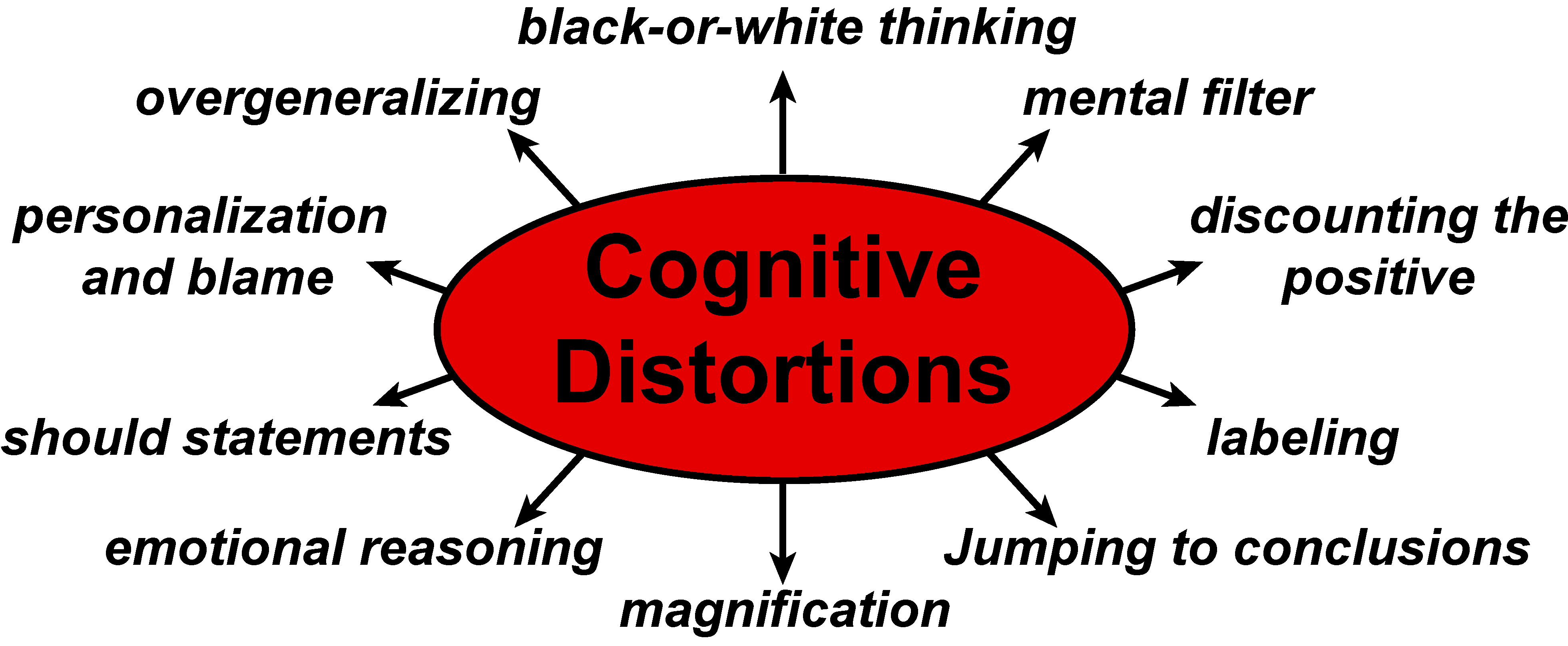Background
Cognitive distortions are fundamental to almost all self-defeating thoughts. Cognitive distortions are common logical fallacies that underlie most negative attitudes or self-defeating thoughts. You can think of them as the steel frame and concrete pillars that are propping up self-defeating beliefs, once they are exposed and removed, the thought has little to stand on.
Cognitive distortions are so common because they give simple immediate answers (although wrong) to many complex situations.
Here are the 10 categories of cognitive distortions present in most distorted thinking, taken from David Burn, MD's book Feeling Good:
1. All-or-nothing thinking (black-or-white thinking) —You see things in black-or-white categories. If a situation falls short of perfect, you see it as a total failure. When a young woman on a diet ate a spoonful of ice cream, she told herself, “I’ve blown my diet completely.” This thought upset her so much that she gobbled down an entire quart of ice cream!
2. Overgeneralization —You see a single negative event such as a romantic rejection or a career reversal, as a never-ending pattern of defeat. This false pattern is reinforced by using words such as “always” or “never” when you think about it. A depressed salesman became terribly upset when he noticed bird dung on the windshield of his car. He told himself, “Just my luck! Birds are always crapping on my car!”
3. Mental filter —You pick out a single negative detail and dwell on it exclusively, so that your vision of all of reality becomes darkened, like the drop of ink that discolors the beaker of water. Example: You receive many positive comments about your presentation to a group of associates at work, but one of them says something mildly critical. You obsess about his reaction for days and ignore all the positive feedback.
4. Discounting the positive —You reject positive experiences by insisting they “don’t count.” If you do a good job, you may tell yourself that it wasn’t good enough or that anyone could have done as well. Discounting the positive takes the joy out of life and makes you feel inadequate and unrewarded.
5. Jumping to conclusions A) Mind Reading B) Fortune-telling — You interpret things negatively when there are no facts to support your conclusion.
A) Mind Reading: - Without checking it out, you arbitrarily conclude that someone is reacting negatively to you.
B) Fortune-telling: You predict that things will turn out badly. Before a test you may tell yourself, “I’m really going to blow it. What if I flunk?” If you’re depressed you may tell yourself, “I’ll never get better”.
6. Magnification —You exaggerate the importance of your problems and shortcomings, or you minimize the importance of your desirable qualities. You blow things way out of proportion or shrink them inappropriately.
7. Emotional reasoning —You assume that your negative emotions necessarily reflect the way things really are: “I feel terrified about going on airplanes. There it must be very dangerous to fly.” Or “I feel guilty. I must be a rotten person.” Or “I feel angry. This proves I am being treated unfairly.” Or “I feel so inferior. This means I’m a second-rate person.” Or “I feel hopeless. I must really be hopeless”.
8. Should statements —You tell yourself that things should be the way you hoped or expected them to be. After playing a difficult piece on the piano, a gifted pianist told herself, “I shouldn’t have made so many mistakes.” This made her feel so disgusted that she quit practicing for several days. “Musts,” “oughts” and “have tos” are similar offenders.
“Should statements” that are directed against yourself lead to guilt and frustration. Should statements that are directed against other people or the world in general lead to anger or frustration: “He shouldn’t be so stubborn and argumentative”
Many people try to motivate themselves with shoulds and shouldn’ts, as if they were delinquents who had to be punished before they could be expected to do anything. “I shouldn’t eat that doughnut.” This usually doesn’t work because all these shoulds and musts make you feel rebellious and you get the urge to do just the opposite. Dr. Albert Ellis has called this “musterbation.” I call it the “shouldy” approach to life
9. Labeling — Labeling is an extreme form of all-or-nothing thinking. Instead of saying “I made a mistake,” you attach a negative label to yourself: “I am a loser.” You might also label yourself “a fool” or “a failure” or “a jerk.” Labeling is quite irrational because you are not the same as what you do. Human beings exist, but “fools,” “losers,” and “jerks” do not”. These labels are just useless abstractions that lead to anger, anxiety, frustration, and low self esteem.
You may also label others. When someone does something that rubs you the wrong way, you may tell yourself: “He’s an S.O.B” then you feel that the problem is with that person’s “character” or “essence” instead of with their thinking or behavior. You see them as totally bad. This makes you feel hostile and hopeless abou improving things and leaves little room for constructive communication.
10. Personalization and blame —Personalization occurs when you hold yourself personally responsible for an event that isn’t entirely under your control. When a woman received a note that her child was having difficulties at school, she told herself, “This shows what a bad mother I am,” instead of trying to pinpoint the cause of the problem so that she could be helpful to her child. When another woman’s husband beat her, she told herself, “If only I were better in bed, he wouldn’t beat me.” Personalization leads to guilt, shame, and feelings of inadequacy.
Some people do the opposite. They blame other people or their circumstances for their problems, and they overlook ways that they might be contributing to the problem: “The reason my marriage is so lousy is because my spouse is totally unreasonable.” Blame usually doesn’t work very well because other people will resent being scapegoated and they will just toss the blame right back in your lap. It’s like the game of hot potato— no one wants to get stuck with it.
instructions
- In the left column, list each automatic thought and rate how much you believe the thought to be true.
- In the middle column, select all the cognitive distortions that apply.
- In the right column, after noticing the cognitive distortion, replace the previously distorted thought with a more rational idea.
- Go back and re-rate how much you now believe in the previous thought.








